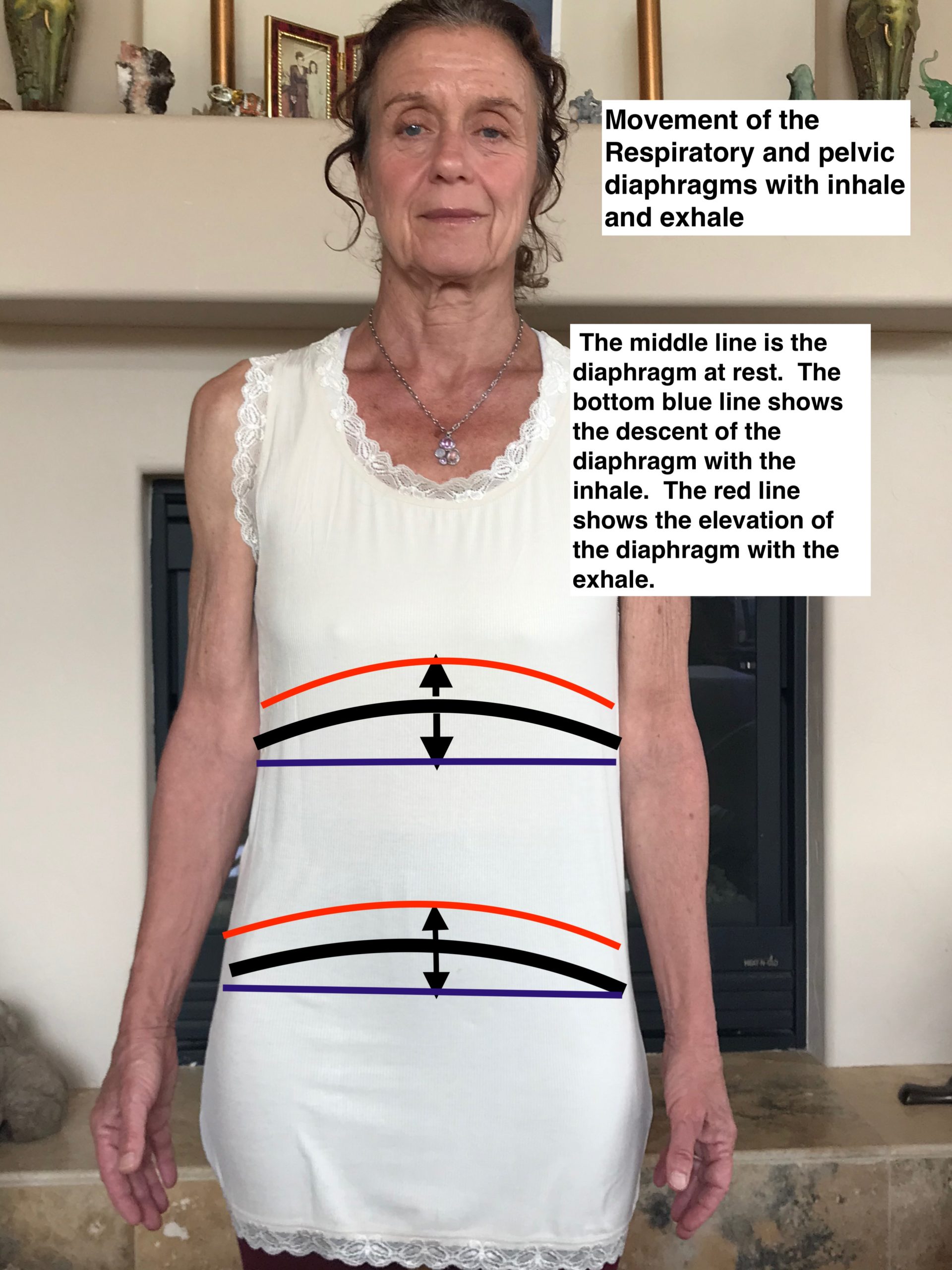Diaphragmatic breathing coupled with pelvic or core breathing will help relax muscular tension throughout our body, decreasing pain and reducing stress. That’s a pretty big statement! How does diaphragmatic breathing and pelvic breathing accomplish that?
Diaphragmatic breathing is also called belly breathing or abdominal breathing. The diaphragm is the primary muscle for respiration. Its shaped kind of like a parachute and separates the chest from the abdomen. It contracts and flattens when you inhale. This creates a vacuum effect that pulls air into the lungs. When you exhale, the diaphragm relaxes and the air is pushed out of lungs. (https://www.healthline.com/human-body-maps/diaphragm)
The pumping action of the diaphragm with inhale and exhale also massages the internal organs and stimulates the lymph nodes in the abdomen. Diaphragmatic breathing down regulates your nervous system, taking you out of fight-or- flight state and helps you to relax and destress.
Conversely, most people tend to breathe with their upper chest muscles. Not only is this inefficient for getting oxygen to our tissues, it also stresses the upper chest muscles causing increased tension in our shoulders, head and neck. It can be a primary cause of neck pain and headaches as well as general increased muscle tone throughout the body.
I learned about pelvic breath or core breath as part of my pelvic floor training. The pelvic floor and diaphragm are meant to move synchronistically. That is, when the diaphragm contracts with the inhale it flattens. The pelvic floor muscles also flatten or expand creating more space with the inhale. When we exhale, the diaphragm retracts back without gripping. The pelvic floor muscles are activated with the exhale, lifting back up to their original position. In other words, the inhalation causes expansion of the pelvic floor while the exhale brings on activation of the pelvic floor. This action happens only if we are breathing correctly and connecting to the pelvic floor.
To be able to do a pelvic or core breath, we first must be able to do a diaphragmatic breath. I used to teach the pelvic breath to my pelvic floor patients until I realized how important it is for everyone. The pelvic breath helps restore the dynamic reflexive action of the pelvic floor muscles.
Steps for Diaphragmatic Breathing and Pelvic Breathing:
- Sit with weight balanced between your sit bones, pubic bone and perineum. Your feet should be flat on the floor with hips, knees and ankles at 90 degrees. Find your neutral pelvis.
- Place one hand on your lower abdomen and one hand on the side of your ribs.
- As you inhale, feel the abdomen expand into your lower hand and your ribs expand laterally into your upper hand. Your upper chest stays relaxed.

Hand position for diaphragmatic breathing
To expand diaphragmatic breathing into pelvic breathing, follow the steps above and add:
- With the inhale- allow your pelvic floor muscles to relax. Your perineum flattens or expands with air coming in.
- With the exhale, the belly moves in (core engages), the pelvic floor lifts and the rib cage softens.

Movement of the respiratory and pelvic diaphragms with inhale and exhale
You may have heard the term, what fires together, wires together. I explained it in the article on neutral pelvis . We don’t think about how we are breathing in our day to day activities. If you have been a habitual upper chest breather, it may be difficult for you to switch to diaphragmatic breathing without some visual cues and practice. Here is a simple practice to help shift from upper chest breathing to diaphragmatic breathing.
- Lie on your back with your knees bent, feet flat.
- Place a heavy book on your lower abdomen.
- Place one hand on your upper chest.
- Inhale feeling your belly expand into the lower abdomen pressing against the book on your belly.
- Your hand on your upper chest stays still.

You can use a book on the abdomen to help facilitate diaphragmatic breathing
Practice this technique until you can easily initiate your breath with your abdomen keeping your upper chest quiet with no elevation of your upper chest muscles.
It can be helpful to have some visuals to help your practice diaphragmatic breathing and pelvic breathing. Here are some suggestions:
- Visualize the dome like shape of the respiratory diaphragm and the pelvic diaphragm.
- As you inhale, visualize the domes flattening or slightly dropping down. As you exhale, visualize the domes returning to their dome shape.
- As you inhale, allow your pelvic floor to relax like when you are sitting to pee.
- In sitting, with the exhale, lift the perineum towards the crown of the head. Relax the perineum fully with the inhale.
- Imagine a jelly fish swimming- it’s body propels up and down like an umbrella opening and closing.
I have a very good video demonstrating Core Breath on my website . A special thank you to Kim Vopni, for letting me use her videos
In summary, diaphragmatic breathing and pelvic breathing will relax muscular tension throughout the body. They down regulate the nervous system promoting rest and relax vs a fight or flight state. Pelvic breath helps restore the dynamic reflexive action of the pelvic floor muscles. This allows the pelvic floor muscles to do the job they were meant to do- support our pelvic organs, provide good sphincter control for bowel and bladder, provide sensation to our pelvic floor and provide stabilization for the lumbar spine and pelvis. Proper breathing should be evaluated while treating any chronic pain pattern. Correcting an inefficient breathing pattern combined with manual therapy is the first step to alleviating pain and promoting long term pain free patterns.
Jody Hendryx, PT
jody@sedonaphysicaltherapy.com


